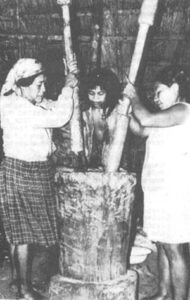Penny Lernoux
- 1976

Fellowship Title:
- The Revolution in the Roman Catholic Church in Latin America
Fellowship Year:
- 1976

1984 Revisited: Welcome To Paraguay
ASUNCION, Paraguay — Travel posters and guidebooks notwithstanding, Paraguay’s much-touted Jesuit missions are no place for a tourist. Not nowadays at least, with military checkpoints on every road and whole villages under siege. So frightened are the people in the region of the missions that few will talk about anything more incriminating than the weather. Diacussion of the local political situation is confined to whispered conversations in locked rooms or the middle of a forest. There is a deja vu atmosphere about these rural towns and churches, for the current repression is a replay of the 18th century. Then as now, the Jesuits were much censored by the large landowners because of their influence over the Indian peasants and their refusal to provide the Spanish haciendas with slave labor. Called “reductions,” these Jesuit missions proved an unusual and successful experiment in Indian socialism that at one time included seven towns with 150,000 Guarani Indians on the red plains of southeastern Paraguay. The conflict with the Spanish colonists lasted a century and a half until 1767
Religious Cold War Heats up in Latin America
SANTIAGO, Chile — When 43 visiting bishops and priests were arrested in Ecuador last month, the Catholic Church was stunned. Though persecution of priests and nuns is becoming commonplace in Latin American countries, the arrest and expulsion of such high-ranking Churchmen, including four U.S. bishops, presaged a dangerous escalation in the ongoing cold war between the continent’s religious and military leaders. While some diplomatic observers attributed the bizarre incident to internal Ecuadorian politics, the bishops put another interpretation on the affair, claiming their arrest formed part of a “concerted plan of action” by South America’s military regimes to harass and undermine the Catholic Church. Because of its moral authority and prestige, the Church is the only institution able to protest the violation of human rights. The price for such temerity, however, has been unprecedented persecution in eight South American countries. (Since the beginning of this year, seven priests and three seminarians have been killed in Argentina alone.) Ecuador’s three-man junta, which is one of the newer, less stable members of the military bloc led by
Christians For Socialism Challenge Catholicism and Communism
ROME, Italy — A political-religious battle is under way in Europe that will shape the future of this continent as well as Latin America. U.S. interests in these countries also will be affected. Known in Europe as the “Catholic question,” the controversy started in 1972 when 400 Latin American priests, nuns and laymen met in Santiago, Chile, to launch an organization called Christians for Socialism (CfS). The movement quickly spread to Europe, and by 1975 CfS organizations were operating in Spain, Portugal, Italy, France, the Low Countries, Austria and West Germany. Spanish migrant workers in Northern Europe also formed a CfS branch. Not surprisingly, Europe’s largest, most active CfS movement is in Italy, where it was founded in 1973 at a meeting in Bologna attended by 2,000 delegates. Thanks to the Latin Americans, Italian Catholics belonging to the Communist and Socialist parties were able to resolve their long-standing dilemma over a dual loyalty to Marx and Christ. “The Latin Americans showed the way by insisting that Christians are free to vote for the party of
Prophets of Change in Latin America
Catholic Bishops Challenge Military
BOGOTA, Colombia — When Pope Paul returned to Rome after a tumultuous welcome in Bogota as the first Papal visitor to Latin America, most journalists figured the story was over. Very few travelled to Medellin in western Colombia, where the Latin American bishops were attending a follow-up meeting sponsored by the Latin American Episcopal Council (CELAM), the hierarchy’s service organization, and then only on the off-chance of some anecdote about the Pope’s visit. Since CELAM had never said or done anything unusual in its 13-year history, no one could have predicted that that meeting in Medellin in 1968 would become the story of the decade, a milestone in Latin American history with more impact than Ernesto “Che” Guevara’s death in Bolivia or Salvador Allende’s fall in Chile. Reversing four centuries of history, the bishops of Latin America startled this Catholic continent by issuing a scathing attack on its ruling classes, on foreign capitalism, poverty and social injustice. Known as the Medellin documents, the bishops’ criticisms have since become a rallying cry for social reform in
The Catholic Church’s Quiet Revolution in Latin America
LOS TEQUES, Venezuela — In the decade since Camilo Torres died in an army ambush in the Colombian Andes, the legend of the guerrilla-priest has gradually faded. Though still revered in some left-wing student circles, Torres no longer inspires the emulation of rebel Latin American religious, many of whom look back on his gesture of joining the guerrillas as misguided or useless. Not only has rural guerrilla warfare failed as a political weapon in the Latin American countries, violence itself is now viewed by the Catholic Church’s progressive wing as counter-productive to meaningful change in political and economic structures. More than Cuba, the recent political upheavals in Chile have shown the Latin American church how easy it is for the “oppressed to become the oppressors.” Any earlier enthusiasm for a Marxist “dictatorship of the proletariat” in Chile has withered with the experience of a violent right-wing military regime. Whatever democracy’s failings, it now seems infinitely preferable to the right- and left-wing dictatorships that rule two-thirds of the Latin American populace. And so Dom Helder Camara,
